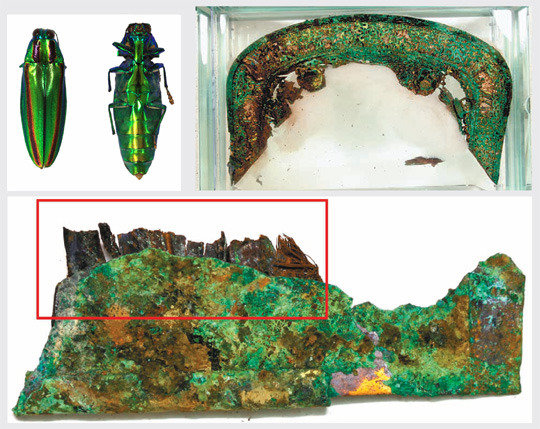Saddle flaps from Silla decorated with jewel beetles discovered
Saddle flaps from Silla decorated with jewel beetles discovered
Posted December. 01, 2017 08:59,
Updated December. 01, 2017 09:46

The wings of jewel beetles have been found on a pair of saddle flapsㅡ a pair of large flaps that project downward from the side of a saddle seatㅡexcavated in the Geumgwanchong Ancient Tomb in Gyeongju. This is the first time that an entire set of harness, from a saddle to a pair of saddle flaps, that is decorated with the wings of the jewel beetles was found from the ancient tombs in the Silla Dynasty.
“An observation of a piece of saddle flap under a microscope found the wings of jewel beetles stuck on a bamboo board,” said the Preservation Science Team of the National Gyeongju Museum Thursday. Usually, it is difficult to find the vestige of the wings of insects as they are easily decomposed.
Jewel beetles, also known as “king of the insects,” are rare insects that emit iridescent lights. They were used to decorate high-class handcrafts in Silla, Goguryeo and Japan. In particular, artifacts from the Silla Dynasty added splendor by placing the wings of the jewel beetles under the ornamental openwork made of gilt bronze. Jewel beetles have been designated as one of the Korean natural monuments as they have become endangered species. The museum had to receive approval from the Cultural Heritage Administration to collect samples of jewel beetles. After a three-day exploration, the museum was able to find a dead jewel beetle with the help of an entomologist in Wando, South Jeolla Province.
The bamboo board of these saddle flaps are covered in a gilt gold case on which Cheonmadoㅡa drawing of a horseㅡis carved out just like the one excavated in Cheonmachong Ancient Tomb. The difference is the one found in Cheonmachong used fabrics instead of jewel beetle wings.
The pair found in Geumgwanchong went through multiple steps of manufacturing process according to the museum. Firstly, a bamboo board was placed on a piece of fabric and then the wings of jewel beetles were put on top of the board. In order to attach the wings to the board, the board had to be lacquered. The board was covered in a gilt gold case with Cheonmado carved on it. Lastly, holes were drilled for screws so that the board and the case do not get separated.
“The wings of jewel beetles were found only on a small portion of the saddle flaps due to decomposition. But it is safe to assume that the entire bamboo board would have been decorated with the wings of jewel beetles judging by the fact that the entire board was varnished with lacquer,” said Lee Seong-ryeol, a research at the museum.
Considering that 2,000 jewel beetles were used to make a restored replica of a “Cantle made of jewel beetles“ excavated in Hwangnam DaeChong Ancient Tomb, a total of 3,000~4,000 jewel beetles are estimated to be used in making the saddle flaps, which is twice the size of the cantle. If a saddle, pedals and horse strap pendants are added to the flaps, a minimum of 10,000 jewel beetles would have been used. “We can assume that the people of Silla put a tremendous efforts in decorating royal tombs,” said Shin Yong-bi, a curator at the museum.
Sang-Un Kim sukim@donga.com







